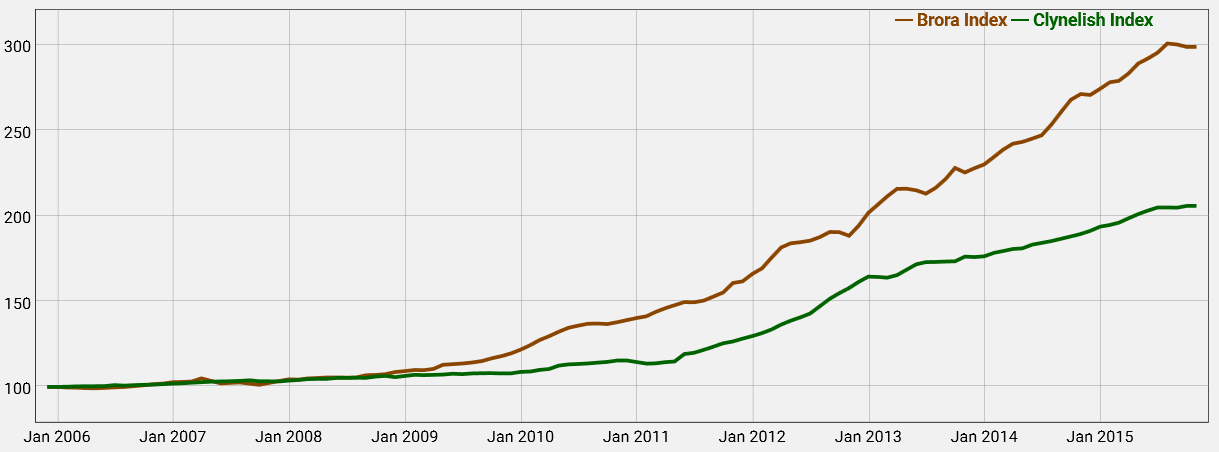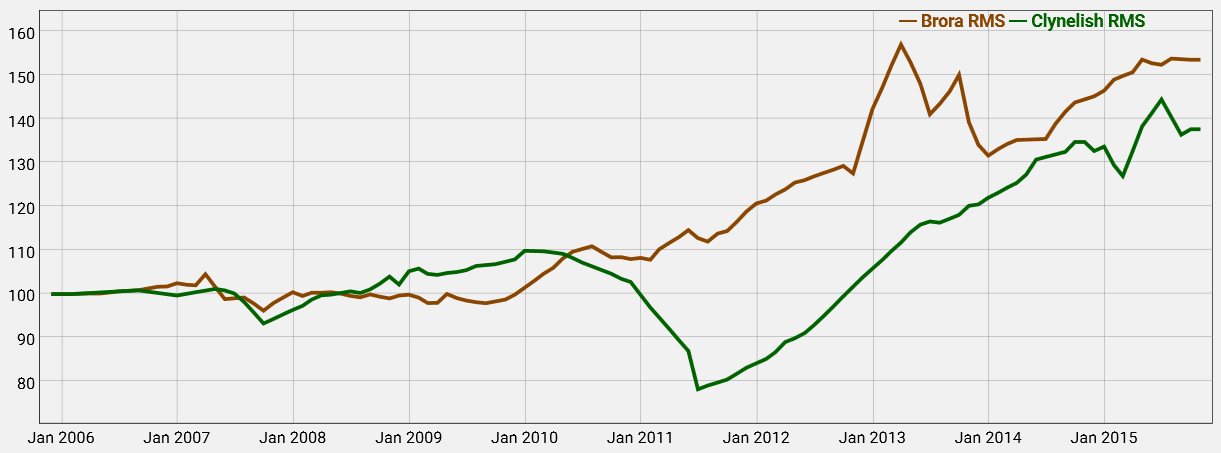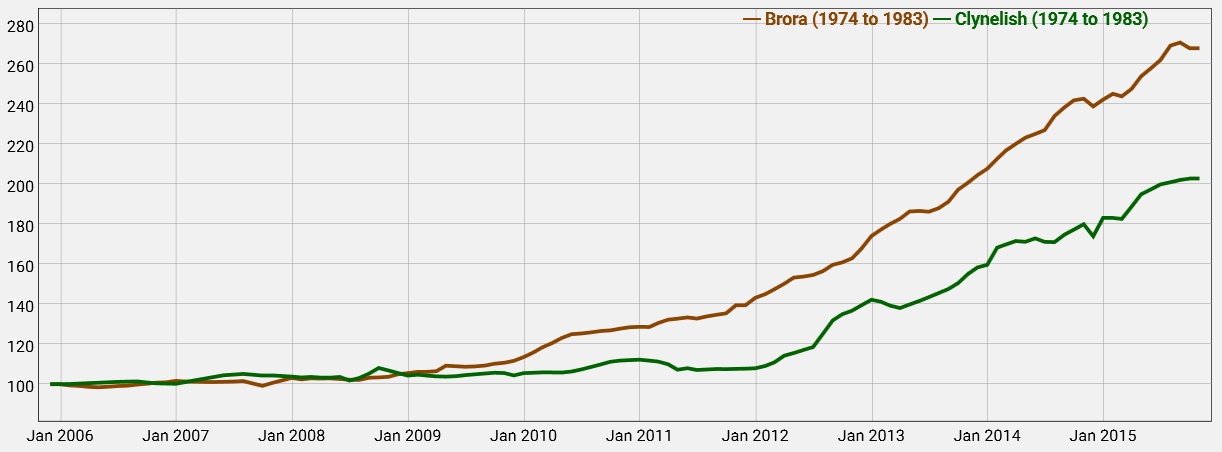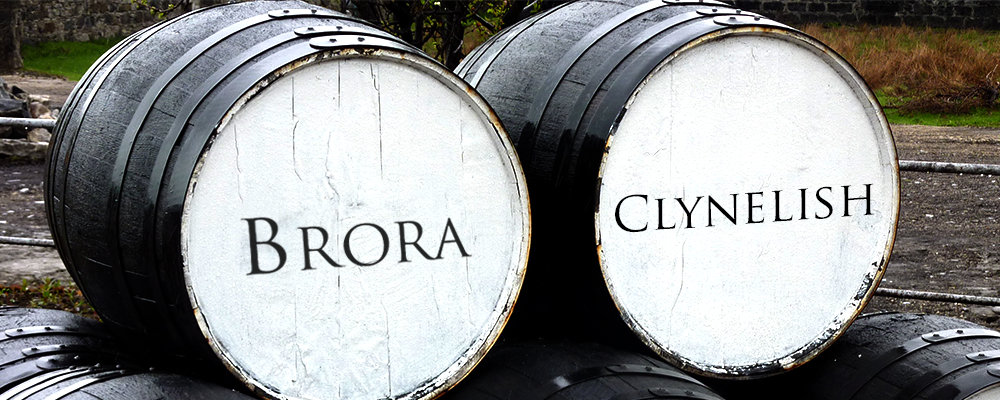Bound by history, separated only by a single street crossing. The Brora and Clynelish distilleries just ask to be compared. This is why we have a closer look at these two Highland scotch whisky producers and their history on the secondary whisky market.
When looking at the family of Highland distilleries, Brora and Clynelish can be seen as the two siblings from the north. Located in the village of Brora and owned by Diageo, the similarities of these two distilleries make the comparison of their performances on the secondary market so interesting. But before we start analysing the corresponding price movements, we have a look into the past.
The Shared History
The Clynelish distillery was founded in 1819 by the Marquis of Stafford, the 1st Duke of Sutherland. Almost 150 years later, in 1968, this distillery was closed and replaced by a new one just across the street. This new distillery, which stills are exact copies of the old ones, was also called Clynelish and represents the distillery as we know it today. Just one year later, in 1969, the old distillery was reopened and named Brora. The reason for this sudden resurrection was a drought on the Isle of Islay which led to a shortage of peated islay malt. To meet the demand on the Johnnie Walker blend, which recipe contained peated islay malt, this new old distillery was used as a replacement. The Brora dsitillery was finally closed in 1983. Since the middle of the 1990s, the remaining Brora single malts are released on a regular basis.
The Distilleries’ Indices
We start off by comparing these distilleries’ whiskystats indices (learn more on these indices here). In short, these indices represent the relative price movement of the most traded Brora and Clynelish bottlings. We see that by October 2015 the 68 included Brora whiskies almost tripled in value. Over the same time period, the index of the 67 most traded Clynelish bottlings “only” doubled. However, the demand for both of these distilleries’ single malts seems to have never really decreased.
When looking at these indices, we wonder if this difference of 100 index points is caused only by the fact that the Brora distillery is closed or also by other factors that could have a significant influence on these prices. To find out, we slice these indices into pieces.
The Rare Malts Selection Series
The Rare Malts Selection (RMS) series is a bottling series issued by Diageo. The main part of this series is devoted to already closed distilleries like Brora. These single malts have all been distilled in the 60s, 70s or early 80s and aged for at least 18 years. Nevertheless, we also find some Clynelish single malts released under this series. All in all there are eight different Broras and six different Clynelishs from the Rare Malt Selection in our database. In order to easily compare the price movements of these bottlings we simply computed their own indices following our methodology explained here.
The first thing we notice is a major drop of the Clynelish RMS in the year of 2011. Responsible for this price pattern are the two 22-year-old single malts that have been distilled in 1972. Both lost more than 50% of their value in the course of 2011. After that, the Clynelish RMS bounced back and is now only 10 points below the Broras, which experienced their descent in the year of 2013. So both, the bottlings from the Brora and the Clynelish RMS series gained significantly in value but do not explain why the Brora index is 100 points above the Clynelish one.
The “Old School” Clynelish Bottlings
As we have already learned, the distillery that we now call Brora bore the name Clynelish prior to 1968. If we have a look in our database, we find four Clynelishs with a vintage older than 1968. So in fact, these whiskies were distilled in the Brora distillery (well, kind of). While all of these four bottlings experienced an increase in price, it is the Clynelish 24yo (Vintage 1965) bottled by Wm. Cadenhead to baffle us all. We observed the first trades of this bottle at the end of 2005 were it was sold for 200 and 250 Euros. The last observed prices come from June 2013 for just less than 3000 Euros. As we tracked five prices of this bottle, it is part of the distilleries index. If we do not include these four bottles in our distillery index, the Clynelish index drops from 200 to 186 points at October 2015. So the difference we try to source just grew.
The Extreme Ones
Another interesting aspect is the comparison of those bottlings that gained the most and the least value over the last decade. To standardise things, we chose the top and bottom ten bottles of each distillery which experienced the most extreme price changes.
What we see is that the top 10 Brora whiskies gained 460% in “value” whereas the bottom 10 Clynelish whiskies are as valuable as they have been ten years ago. What is even more impressive is that the bottom 10 Broras doubled in value! After all, the prices of the ten most haunted Clynelish single malts quadrupled. So there are already big differences when we look at the most extreme pricemovements. To narrow down the Brora distillery’s “effect of silence”, we will now compare only those bottles which are really comparable.
The Class Mates
According to various resources like the Malt Whisky Yearbook 2016, the peatiness of the Brora single malts was reduced after 1974. Hence, the whiskies from Brora and Clynelish which were distilled between 1974 and 1983 should be as comparable in quality as whiskies can get. So what if we only consider those Clynelish and Brora bottlings that were distilled in the time period of 1974 to 1983? To answer this question, we of course computed the appropriate indices.
And what we see is that the 14 Clynelish bottlings that were distilled from 1974 to 1983 doubled in value whereas the prices of the 55 Brora malts from the same time period climbed by 168%. So there is still a difference of 68 points!
It is time to sum up our results before we lose ourself in too many details. The single malts of these two distilleries experienced a comparable evolution in price. The only difference is the scale of the increase. Since the Brora distillery is closed and very unlikely to be opened again somewhen soon, it is only natural that the prices of its whiskies are higher than those of Clynelish. We tried to assess this “effect of silence” by only comparing the comparable bottles. Thereby we found out that our best guess for the magnitude of this effect could be something around 60 index points. In other words, the bottles of the already closed Brora distillery gained 60% more of their value than those of the still operating Clynelish distillery.
